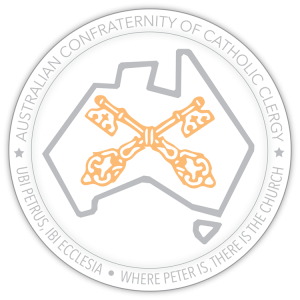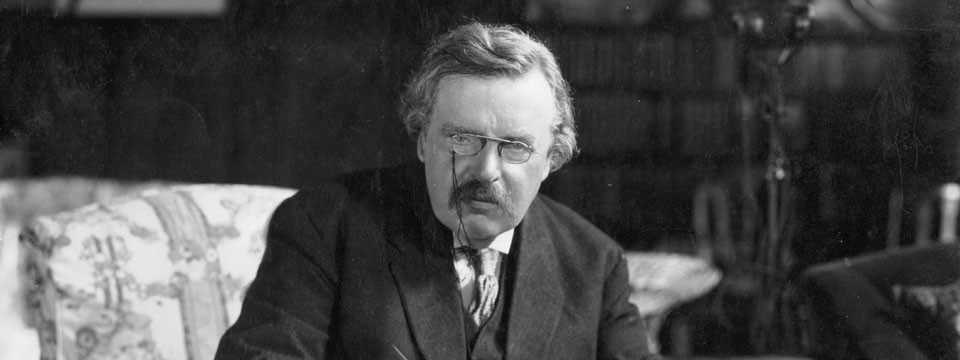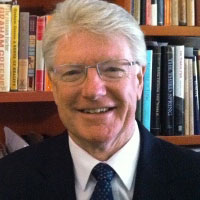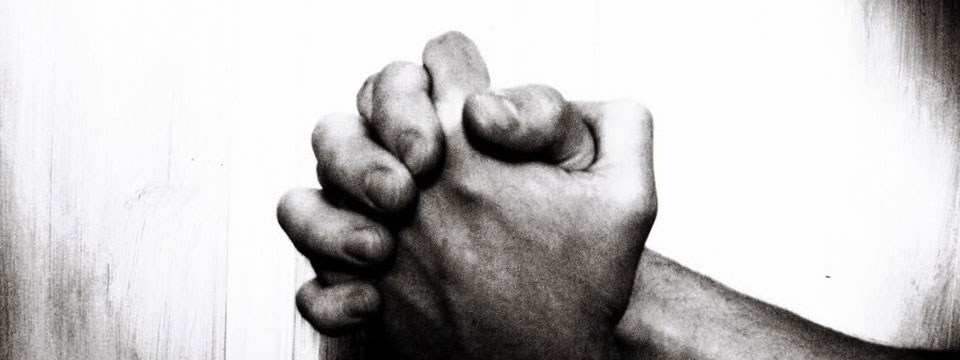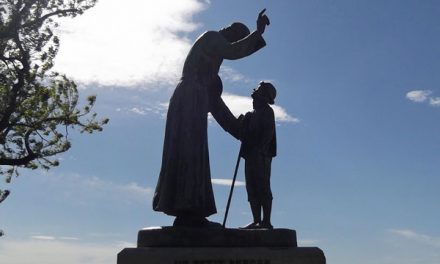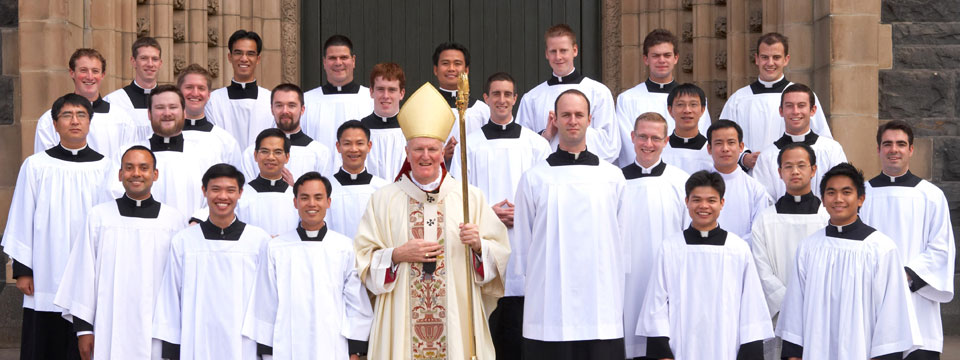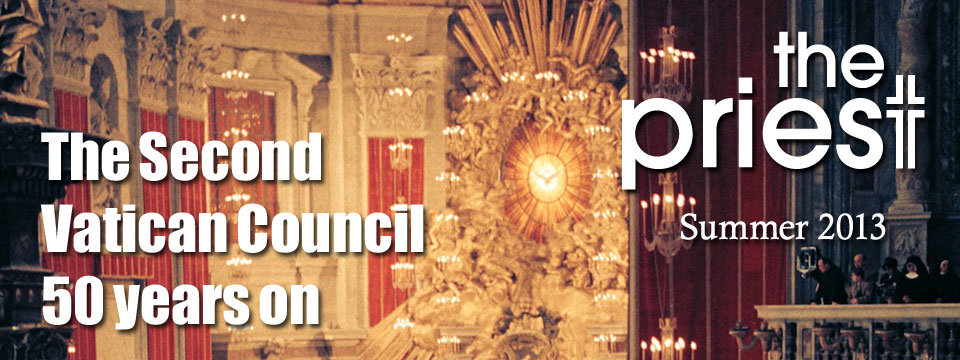G. K. Chesterton was a prolific writer on all manner of subjects, and my particular focus will be on one vital part of his life and thought; namely, his inner life or spirituality.
When Chesterton was asked to explain why he had become a Catholic, a step which he took rather late in his life, when he was nearly 50, he briefly – and famously – replied: “To get rid of my sins.”{{1}}
This was a surprising and even startling answer – that Chesterton had joined the Catholic Church because of its practical power of dealing with sin. He had, indeed, long been thought to be on the threshold of the Catholic Church. His great work of Christian philosophy, Orthodoxy, was published as early as 1908, a full 14 years before he entered the Catholic Church. On his death in 1936, Cardinal Pacelli (as he then was – later Pope Pius XII) bestowed upon him the title “Defender of the Faith.”
But the particular answer which Chesterton gave to the question, “Why did you join the Church of Rome?” is surprising, I think, for two reasons. First, it may be thought that Chesterton’s reputation as a controversialist would have produced a reason for his conversion based on philosophy or history – the compelling logic of the Catholic faith as an explanation of life, or the Church’s long record of influence on human civilisation and history. But Chesterton pointed, rather, to a personal factor: a highly spiritual motive, a reason related to his soul.
The second surprising aspect of Chesterton’s explanation is that it seems so out of keeping with the well-known and widely attested image of his innocence and goodness: his playfulness, his kindly character, his capacity to retain the affection of those (like George Bernard Shaw and H. G. Wells) with whom he engaged incessantly in intellectual combat. Remarkably, for a man who engaged endlessly in controversies, Chesterton was able to distinguish between the man and the idea. He could argue without quarrelling.{{2}}
There has been serious consideration given to proposing Chesterton’s cause for canonisation. The process began some time ago in Argentina. I was amazed, when I spoke at a Chesterton conference in Buenos Aires several years ago, the intense interest in promoting the idea of ‘St Gilbert Chesterton”. More recently, there has been a ripening of interest in England. In July 2009, a conference was held in Oxford to examine the question of Chesterton’s holiness. Chesterton himself would have regarded such a notion as preposterous: he was a genuinely and ingrainedly humble man who suspected his goodness, still more his holiness.
Yet a careful reading of Chesterton would have occasioned no amazement at his stated reason for conversion – that he wanted to get rid of his sins. In the years since his death in 1936, one of the advances in understanding about him has been that his frivolity, his “toby-jug” image and celebration of Merrie England, his weakness for light puns and clever paradoxes, were only part of him, and not necessarily the most important part. I would not want to suggest that we should ignore or underrate this dimension of Chesterton – especially his humour and his ability to laugh at himself. Many would be familiar with the stories that Chesterton told against himself, especially relating to his size (he was a tall man and he weighed nearly 160 kilos); for example, the occasion when, in a gesture of politeness, he got up and gave his seat to three ladies in a bus.{{3}}
Chesterton’s absent-mindedness was legendary. He himself used to say that “absence of mind” is simply the presence of mind on something else! Perhaps the most celebrated example of his “presence of mind on something else” was a telegram he sent to his wife, Frances, when he had left for a speaking engagement in some city. The telegram read:
Am in Market Harborough. Where ought I to be?
Thus, in considering the fullness of Chesterton’s mind and spirit, I do not want to diminish his wonderful qualities of humour and light-heartedness. My point is that there is another side of Chesterton which has become more significant, and more appreciated, in recent decades.
Probably the insights of the Argentinian writer, Jorge Luis Borges, have been decisive in painting a fuller picture of Chesterton’s character and outlook, and of his inner life. Borges saw in Chesterton dark strains and hints of horror. Beneath the surface sparkle of wit and optimism lurked a fear that the world is a depraved and diabolic place. Chesterton, argued Borges, “restrained himself from being Edgar Allan Poe or Franz Kafka, but something in the make-up of his personality leaned towards the nightmarish, something secret, and blind, and central.”{{4}}
A similar observation was made by Malcolm Muggeridge after he re-read Chesterton’s autobiography in the 1960s:
Underneath the happy Christian and happy husband, the lover of peasants, Fleet Street roistering and country inns, one senses in Chesterton a brooding, anguished, frightened spirit; a frustrated romantic, a displaced person, a letter delivered at the wrong address.{{5}}
Such a view of Chesterton may indeed be an exaggeration. But this insight into the darker depths of Chesterton’s being capture a key truth about him – one which can be readily documented from his writings, and which is certainly pertinent to any enquiry into his inner life.
Such an enquiry, of course, is presumptuously ambitious, for Chesterton’s inner life is finally known only to God. We can but look at its external manifestations or verbal expressions. With that disclaimer, I would like to attempt to shed light on three areas: Firstly, the extent to which Chesterton’s spiritual life was conditioned by his own sense of sin; secondly, the ways in which his spiritual outlook grew out of a natural theology of wonder and surprise and thanksgiving; and thirdly, the major aspects of the Catholic devotional tradition which appealed to Chesterton.
In short, I’ll be exploring the wellsprings of Chesterton’s spirituality, and then its channels of expression.
Chesterton’s sense of sin
To take the first theme, it is important not to overlook in Chesterton a crucial fact about him – namely, his deep and unflinching grasp of evil, and of the personal evil that is sin. In his autobiography, written at the end of his life and published posthumously, he offers a comment – in the section just before he speaks of becoming a Catholic to “get rid of his sins” – about the Church’s understanding of evil. This, he has to admit, surprised him:
That the Catholic Church knew more about good than I did was easy to believe. That she knew more about evil than I did seemed incredible.{{6}}
Chesterton wrote an early and remarkable essay, a work of seminal importance called “The Diabolist”. This essay brings out powerfully a major theme of his later writings, a key understanding that he had about modern culture – namely, its utter loss of objective truth and reality, and its inability to recognise intellectual distinctions.
Chesterton recalls, in this essay, a conversation he had with a stranger, the diabolist, which he describes as “by far the most terrible thing that has ever happened to me in my life.”{{7}} The diabolist showed “a horrible fairness of the intellect that made me despair of his soul.” He embraced good and evil indiscriminately and, believing that evil had a life of its own, he pursued it as energetically as good.
I have sometimes thought that Chesterton showed a prophetic insight into the whole development in our culture of the “pro-choice” mentality, not just in relation to abortion but to so many other key moral issues – the idea that one can choose good or evil indiscriminately; that the outcome does not matter, only the act of choice, and the sovereignty of choice.
In this essay, Chesterton hears the diabolist’s final words, and they sear his consciousness to such an extent that he has never forgotten them. He heard the diabolist say: “I tell you I have done everything else. If I do that I shan’t know the difference between right and wrong.” Symbolically, this conversation took place near a bonfire which sent its red sparks into the air. After Chesterton heard these last words of the diabolist, he rushed away, and as he passed the fire, he did not know, he said, “whether it was hell or the furious love of God.”{{8}}
The elements of this early essay say a great deal about Chesterton. There is a brush with evil, a consciousness of sin, a sense of loss, a spirit of humility. All are relevant to the spiritual life, and they characterise Chesterton’s attitude and experience.
Not long before his conversion in 1922, Chesterton gave an insight, in a private letter, into the depths of his soul. He wrote to Mgr Ronald Knox in these terms:
I am in a state now when I feel a monstrous charlatan, as if I wore a mask and were stuffed with cushions, whenever I see anything about the public G. K. C.; it hurts me; for though the views I express are real, the image is horribly unreal compared with the real person who needs help just now. I have as much vanity as anybody about any of these superficial successes while they are going on; but I never feel for a moment that they affect the reality of whether I am utterly rotten or not; so that any public comments on my religious position seem like a wind on the other side of the world; as if they were about somebody else – as indeed they are. I am not troubled about a great fat man who appears on platforms and in caricatures; even when he enjoys controversies on what I believe to be the right side. I am concerned about what has become of a little boy whose father showed him a toy theatre, and a schoolboy whom nobody ever heard of, with his brooding on doubts and dirt and daydreams, of crude conscientiousness so inconsistent as to be near hypocrisy; and all the morbid life of the lonely mind of a living person with whom I have lived. It is that story, that so often came near to ending badly, that I want to end well.{{9}}
There is a similarity between Chesterton’s attitude to childhood and that of the French Catholic novelist Georges Bernanos. In both authors, there is a deep sense of the loss of childhood – representing the condition of sin, and also hints of the human longing for redemption. Like Bernanos, Chesterton saw childhood as an image of man’s supernatural state and calling. He believed that the recovery of childlike (not childish) attitudes and values was the pathway to communion with God.{{10}} I think both Chesterton and Bernanos took very seriously Christ’s warning, that “unless you be converted and become like little children, you will never enter the kingdom of heaven.” (Matthew 18:3)
What was the nature of the temptations which assailed Chesterton – what he called “those morbid but vivid problems of the soul”?{{11}} One line of speculation is that the temptations were sexual, probably homosexual;{{12}} but there is absolutely no evidence that Chesterton engaged in, or was inclined towards, such behaviour. In fact, in his autobiography, he specifically rejected the idea that he was prey to such temptations. He noted that he had “never indeed felt the faintest temptation to the particular madness of [Oscar] Wilde.”{{13}}
Whatever the nature of the temptations experienced by Chesterton, the deep truth about him, I think, is that he encountered evil in his mind and heart, and recognised it as real. In the concluding paragraph of “The Diabolist” essay, he remarks that the diabolist subsequently died – perhaps, even committing suicide; “though he did it,” writes Chesterton, “with tools of pleasure, not with tools of pain.” Then the final, provocative sentence:
God help him, I know the road he went; but I have never known, or even dared to think, what was that place at which he stopped and refrained.{{14}}
A more direct hint as to the nature of the spiritual and moral tests which Chesterton underwent is an extraordinary prophecy he stated in 1926:
The next great heresy is going to be simply an attack on morality; and especially on sexual morality. And it is coming, not from a few Socialists surviving from the Fabian Society, but from the living exultant energy of the rich resolved to enjoy themselves at last, with neither Popery nor Puritanism nor Socialism to hold them back … The roots of the new heresy, God knows, are as deep as nature itself, whose flower is the lust of the flesh and the lust of the eye and the pride of life. I say that the man who cannot see this cannot see the signs of the times; cannot see even the sky-signs in the street that are the new sort of signs in heaven. The madness of tomorrow is not in Moscow but much more in Manhattan – but most of what was in Broadway is already in Piccadilly.{{15}}
This passage not only testifies to Chesterton’s remarkable prescience – in so many ways, Chesterton was a prophet who discerned the full outcome of trends long before the effects became evident to others – but the passage also reflects something significant about Chesterton personally; namely, that only a man who understood the power of lust could have envisaged such a future; or, indeed, recognised such a past. For Chesterton also saw the profound effects of disordered sex in history. In his biography of St Francis of Assisi (1923), he noted the final unfolding of the ancient Roman tradition of nature-worship, which led to “natural passions becoming unnatural passions:”
Thus the effect of treating sex as only one innocent natural thing was that every other innocent natural thing became soaked and sodden with sex. For sex cannot be admitted to a mere equality among elementary emotions or experiences like eating and sleeping. The moment sex ceases to be a servant it becomes a tyrant.{{16}}
As Chesterton remarked many years earlier, the appeal to animal appetite has a submissive, not a liberating, effect on the imagination:
Indecency is not wild and lawless. The danger of indecency is exactly that it is tame, dull, direct, inevitable; a mere law in the members. It is automatic evil. Pride makes a man a devil; but lust makes him a machine.{{17}}
Chesterton’s wonder at the natural order
A second aspect of Chesterton’s spirituality was his sense of wonder and gratitude about the created world. This formed the primary ground of his relationship with God. Early in his writing career, Chesterton spelt out his essential philosophy:
Of one thing I am certain, that the age needs, first and foremost to be startled; to be taught the nature of wonder.{{18}}
Such an outlook was central to Chesterton’s understanding of life and of reality. Even when he abandoned Christianity – he recalls that he was a pagan at the age of twelve and a complete agnostic by the age of sixteen{{19}} – he never lost this fundamental sense of loyalty and gratitude. “I hung on to the remains of religion,” he said, “by one thin thread of thanks.”{{20}}
Chesterton harboured a profound love of creation and was filled with the spirit of gratitude which that love excited – perhaps nowhere more memorably articulated than in a well-known passage from his book, Orthodoxy:
Children are grateful when Santa Claus puts in their stockings gifts of toys or sweets. Could I not be grateful to Santa Claus when he put in my stockings the gift of two miraculous legs? We thank people for birthday presents of cigars and slippers. Can I thank no one for the birthday present of birth?{{21}}
It can be argued that this attitude of Chesterton’s is intimately linked with the first theme we explored; namely, that his sense of goodness flowed from his sense of evil, and of the need for God’s mercy and forgiveness. T. S.Eliot once suggested that only the person who knows evil is sufficiently alive to know good; that without a knowledge of and capacity for evil, there is not the capacity for good.{{22}} There are echoes of that experience in Chesterton’s outlook.
At the same time, there is something distinctly pure and primitive about the primary celebration of life in Chesterton. There is a vision of natural splendour, akin to Adam’s condition before the Fall; an intuition of fundamental love and joy. This comes out especially in Chesterton’s powerful sense of beauty – for example, in his vivid descriptions of everyday nature. He possessed a strongly visual imagination. This was no doubt tutored by his experience at the Slade School of Art in London, but Chesterton showed an innate ability of painting with words. Witness this paragraph from one of his early novels, The Man Who Was Thursday:
Under the white fog of snow high up in the heaven the whole atmosphere of the city was turned to a very queer kind of green twilight, as of men under the sea. The sealed and sullen sunset behind the dark dome of St. Paul’s had in it smoky and sinister colours – colours of sickly green, dead red or decaying bronze, that were just bright enough to emphasise the solid whiteness of the snow. But right up against these dreary colours rose the black bulk of the cathedral; and upon the top of the cathedral was a random splash and great stain of snow, still clinging as to an Alpine peak. It had fallen accidentally, but just so fallen as to half drape the dome from its very topmost point, and to pick out in perfect silver the great orb and the cross. When Syme saw it he suddenly straightened himself, and made with his sword-stick an involuntary salute.{{23}}
In his mature years, Chesterton’s natural intuitions were elevated and transmuted into supernatural understandings – the springs of poetry and not just of prose. In the final years of his life, he was still combating the suffocating spirit of pessimism and weariness that threatened to engulf Western culture at that time – and still does, perhaps in a more pervasive way, as captured by Pope John Paul II in his vivid phrase, the “culture of death”. In a BBC broadcast entitled “The Spice of Life”, delivered only three months before he died, Chesterton quoted from T. S. Eliot’s poem, “The Hollow Men”:
This is the way the world ends
This is the way the world ends
Not with a bang but a whimper.
Chesterton contested this pessimism fiercely. He knew that the world was perishable and would end, but he “did not think it would end with a whimper, but, if anything, with a trump of doom.” His response to the “young pessimists” of the 1930s was to burst into song:
Some sneer; some snigger; some simper;
In the youth where we laughed, and sang.
And they may end with a whimper
But we will end with a bang.{{24}}
We gain a further insight, if indeed an oblique one, into the fundamental conviction of Chesterton’s profound affirmation of life and of love, from the poignant testimony of his wife Francis, provided after her husband’s death in 1936. In a letter to Father John O’Connor, a priest-friend of Chesterton’s who formed the model for his famous priest-detective, Father Brown, Francis Chesterton wrote:
The feeling that he needs me no longer is almost unbearable. How do lovers love without each other? We were always lovers.{{25}}
Francis, in fact, survived her husband by only two years. “What did Francis die of?” George Bernard Shaw asked Maisie Ward. “Was it of widowhood?”{{26}}
Chesterton’s religious reserve
The third and final theme I’d like to address is the devotional side of Chesterton’s religious life – his participation in the spiritual practices usually associated with the Catholic life. An initial observation is that, while allowing for the emotional reticence of Victorian England in matters religious, Chesterton did not appear to take part easily or frequently in Catholic devotions. During his Anglican days, the Rector of Beaconsfield (the village between London and Oxford where Chesterton lived) commented to a parishioner that he was glad Gilbert Chesterton had gone over to Rome, “because he had always been a very bad Anglican, and presumably he would become a good Roman Catholic.”{{27}}
Chesterton’s biographer, Maisie Ward, records that all who knew Chesterton remember him as reserved (as she put it) “to an almost morbid degree” about any outward manifestation of his spiritual life. He told the priest who ministered to him his First Communion that this was “the happiest hour of [his] life”{{28}}, but it seems that he seldom received the Blessed Eucharist. On one occasion, when Holy Communion was brought to his wife Frances at their home, he expressed the trepidation that he felt by saying: “I am a simple man and I am afraid when God comes to my house.”{{29}}
In 1933, on the feast of Corpus Christi, he met a friend as he was coming out of early Mass. At that time he was writing a biography of St Thomas Aquinas, and was conscious of the liturgy which St Thomas had written in honour of this great feast – and no doubt, as well, the hymn he had composed, Pange Lingua, the last two verses of which, Tantum Ergo, are still sung at Benediction. Almost apologetically, Chesterton said to his friend:
As I’ve been trying to write about St Thomas, I thought the least I could do was to go to Communion on the day he wrote his Mass.{{30}}
It seems to me important with Chesterton, and perhaps with most of us, to draw a distinction between religious feeling and religious experience. When the Catholic convert and apologist Sir Arnold Lunn wrote about this distinction in relation to Chesterton’s fellow Catholic, Hilaire Belloc, he noted that religious experience is the reward of the struggle against temptation and of the practice, however imperfect, of virtue. Religious feeling, on the other hand, is an extra. It is something that many saints were denied, for long periods of their lives, experiencing great spiritual dryness. They had to manage without a spiritual consolation that many others have found in prayer and in praise.{{31}} It’s clear, I think, as Robert Speaight wrote in his biography of Hilaire Belloc, that Chesterton knew what it meant to exercise the theological virtues of faith, hope and charity. His abounding goodness may not have been apparent to him, but it was, as Speaight said of Belloc, apparent to other people – “and that is the test.”{{32}}
There are two important signs of Chesterton’s religious experience that bear on his spirituality. First, he cherished a genuine interest in the saints. He produced biographies of St Francis of Assisi (1923) and St Thomas Aquinas (1933), which allowed him to deal with the two figures who represented those aspects of the Catholic faith which he found most inspiring – a devotion to the truth and a championing of the poor. It is summed up neatly in the last lines of a sonnet that Mgr Ronald Knox wrote on Chesterton’s death:
Take him, said Thomas, for he served the truth;
Take him, said Francis, for he loved the poor.{{33}}
Apart from the saints, the second – and highly significant – object of Chesterton’s religious devotion was undoubtedly the Virgin Mary. There were at least three distinct elements to this, which contributed to a deep sense of consecration on Chesterton’s part. The first is Mary’s role as the Mother of God. In a book of essays published in the year before his death, Chesterton writes of the cult of Mary. He notes that Our Lady reminds us especially of God Incarnate, and in some degree gathers up and embodies “all those elements of the heart and the higher instincts, which are the legitimate short cuts to the love of God.”{{34}}
Chesterton felt that his approach to the Catholic Church was very much an approach to Mary:
The instant I remembered the Catholic Church, I remembered her; when I tried to forget the Catholic Church, I tried to forget her.{{35}}
Chesterton’s poetry in particular contains strong Marian inspiration – for example, The Ballad of the White Horse, in which Our Lady gives King Alfred instruction and courage and to Our Lady, Arthur dedicates, after victory, “this land” [of England].{{36}}
But most notable is Chesterton’s book of poems called Queen of Seven Swords. In this work, Chesterton refers to a “seven-fold splendour” surrounding Mary, which corresponds to the seven wounds of Christ. The book itself contains seven poems which represent the supreme expression of Chesterton’s love for the Mother of God – and for the one he regarded as his own spiritual mother.
And men looked up at the woman made for the morning
When the stars were young,
For whom, more rude than a beggar’s rhyme in the gutter,
These songs are sung.{{37}}
The culmination of these poems is Chesterton’s evocation of seven saints – great champions of Christendom, representing different countries (such as St James of Spain, St Anthony of Italy and St Patrick of Ireland). These saints have suffered apparent defeat in the cause of the Faith, and they return to Mary to find that she has hidden their swords where the Gospels tell us that Mary hid and pondered all things: in her heart. From her wounded heart, Our Blessed Mother takes the seven swords to rearm the saints who are called to reconquer the earth for Christ.{{38}}
A second element in Chesterton’s Marian devotion is the cult of chivalry. He cherished the great – though now rapidly vanishing – tradition of European chivalry and courtly honour. This tradition, Chesterton believed, was a noble expression of the civilised order which Christianity had brought to Western culture, giving form and dignity to human relationships, particularly between men and women. It’s common to describe the code of chivalry as “romantic”, but Chesterton maintained that it was, on the contrary, realistic – in fact, the most realistic view of the sexes. “It is so realistic,” he wrote, “that the real reasons for it cannot always be given in print.”{{39}}
Chesterton’s attitude to women was informed by a spirit of gallantry. This is shown most clearly in his devotion to his wife Frances. He fell in love with her at first sight, and an early poem he composed about her was entitled “To My Lady.”{{40}} His love for her remained unconquerably strong throughout his life.
Chesterton certainly had about him the quality of a medieval knight – a sort of Don Quixote figure.{{41}} He took pride in what he called “the banner of the mystery of chivalry: the Christian courage which is a disdain of death.” This is the courage of the hero, he believed, and it’s sharply different from the so-called courage of suicide, which Chesterton said is a “disdain of life.”{{42}}
An intriguing sign of Chesterton’s identification with crusading knights was his fondness for knives. He carried a huge knife around with him for many years, and often played with it. It gave rise to some amusing incidents – for example, at a lecture in Dublin when he drew the knife absent-mindedly in order to sharpen a pencil!{{43}} He also had a sword-stick which he would brandish at times. Father John O’Connor recalled Chesterton’s making deadly passes with his sword-stick at the dahlias in his garden.{{44}} This can, of course, be seen as an affectation – a part of his public image of eccentricity. But Chesterton himself saw the sword as an instrument of chivalry and a symbol of manhood. Carrying it around had historically distinguished the free man from the slave.{{45}} His brother Cecil said that Chesterton nursed the hope that, some day, there would be an incredible happening on the streets of London which would compel him to protect himself with his sword.{{46}}
A third element in Chesterton’s love of Our Lady is her association with traditionally Catholic countries, in particular Ireland. Chesterton felt that this special land had registered a deep impact on his religious faith – dragging him, as he put it, in the divine direction of the Church long before he met various Catholic friends who influenced him, such as Hilaire Belloc and Maurice Baring.{{47}} Chesterton wrote two books on Ireland, Irish Impressions (1919) and Christendom in Dublin (1933). In both works, he refers to a legend about Our Lady which had a profound effect on him. In Christendom in Dublin, Chesterton places the legend in the context of his own life, on an occasion when he was looking for an image of the Virgin Mary to give to the new church in Beaconsfield where he lived. It’s clear that this experience brought home to him the great simplicity and intimacy of the Mother of God, in a way that nothing else had.{{48}}
Chesterton recalled a story he had once heard in Donegal – of someone meeting, in the rocky wastes, a beautiful peasant woman carrying a child, and who, on being asked for her name, answered simply:
I am the Mother of God, and this is Himself, and He is the boy you will all be wanting at the last.
While looking for a Marian image for his local church, Chesterton saw all kinds of examples in a Catholic shop in London, but none appealed to him. Then, as he accompanied the proprietor to an upper storeroom, he noticed a statue. “[S]he was standing there,” he said, “amid planks and shavings and sawdust, as she stood in the carpenter’s shop in Nazareth.”{{49}} The proprietor said that it had just arrived from Ireland – but, even without being told, Chesterton recognised it as unmistakably Irish. The colours were traditional, he thought, but not conventional. The figure was at once a peasant and a queen – and in that sense, he said, a lady. “she was barefoot like any Colleen on the hills; yet there was nothing merely local about her simplicity.” Chesterton now sees the little church where this image of Our Lady stands: she is looking out with an intense earnestness, and Chesterton wistfully imagines her speaking these legendary words across that emptiness: “I am the Mother of God and this is Himself, and He is the boy you will all be wanting at the last.”{{50}}
A Carmelite priest, Fr Noel O’Donoghue, has commented that it would be easy to dismiss this story as rather coy and sentimental, except for the fact that, in Mary, Chesterton had found a further vital dimension of God’s revelation, which helped save him from the terrors that were always lurking in the depths of his heart. In Fr O”Donoghue’s words:
[Chesterton] could find no way to deal with this side of his being except through the Catholic-feminine, and ultimately, through that utterly bare and utterly holy feminine that had its home in Ireland of the long centuries of sorrows and enduring faith.{{51}}
Thus, Chesterton’s spirituality found expression in various ways – first, in certain devotional beliefs (particularly a love of Our Lady, not only in terms of her creative purity, as the virginal Mother of God, but also as the one who has helped those who have suffered in being faithful to her Son, notably in nations of Catholic suffering such as Ireland and Poland); and, secondly, in good works – as a journalist who stood for the truth and fought for justice for the poor.
In many ways, this cluster of spiritual beliefs and traditions is summed up in the conclusion Chesterton wrote to a book on marriage called The Superstition of Divorce. It expresses his belief in the goodness of natural creation and in the need for supernatural life, if even the natural is to be saved. It is not the supernatural that disgusts [the pedants], so much as the natural. And those of us who have seen all the normal rules and relations of humanity uprooted by random speculators, as if they were abnormal abuses and almost accidents, will understand why men have sought for something divine if they wished to preserve anything human. They will know why common sense, cast out from some academy of fads and fashions conducted on the lines of a luxurious madhouse, has age after age sought refuge in the high sanity of a sacrament.{{52}}
Summing up
I would like to conclude with a brief reference to Chesterton and the new Catholic college of higher learning with which I am associated – Campion College Australia. In many ways, Chesterton could serve as a model of the kind of graduate which Campion aspires to produce.
For several reasons, Chesterton offers something of a model for a Catholic Liberal Arts college:
He had a mind of tremendous depth and delicacy, a profound capacity for reason and discrimination – for intellectual judgment.
He commanded a prodigious knowledge across the Liberal Arts – the key disciplines which still shape and inspire the mind of an educated person – history, philosophy, literature, language, theology, and science. These are the foundational subjects of a liberal arts program, and they form the core curriculum at Campion College.
He was a superb communicator – both in writing, of course, but also as a speaker and broadcaster. (He made many radio broadcasts in the later years of his life.)
He was a man of great faith and spiritual devotion and moral character, even if his deeply religious disposition did not, as we’ve explored, translate easily into overt practices of piety.
To my mind, all these qualities of Chesterton’s – the power of his mind, the richness of his knowledge, his ability to capture meaning in a single image and in a handful of words, and, finally, the sheer beauty of his faith – are summed up in a poem in The Queen of Seven Swords. Called “A Little Litany,” the poem depicts Mary and the Child. Jesus is crawling up from his mother’s lap and, reaching her face, looks into her eyes. Because Mary is free of Original Sin, only her eyes could accept the direct gaze of God. And Chesterton writes:
[Jesus] found his mirror there; the only glass
That would not break with that unbearable light
Till in a corner of the high dark house
God looked on God,
as ghosts meet in the night.{{53}}
What an extraordinary image this is! The child Jesus peers into his mother’s eye and finds a mirror of himself. “God looked on God” through the incarnational purity of his mother. As the Chesterton critic Dale Ahlquist has asked: can we find in all of literature a more profound and provocative image than God looking at God in the reflection of his mother’s eye?
Chesterton was an artist, and only a man with the eyes of faith could conceive of such a stupendous reality. The English novelist Anthony Burgess once said of Chesterton that he “knew what it was like to live on the level of eternity.”{{54}} The hope and prayer which I have is that Chesterton’s vision of eternal life, expressed in his writings and embodied in his life, will come to be recognised more and more in the 21st century.
[[1]] G. K. Chesterton, Autobiography (London: Hutchinson, 1936), p. 329.[[1]]
[[2]] A lecturer who spent some time with Chesterton during one of his visits to an American college recalled how he was never patronising in his attitude when he argued. While he was quick to disagree, he was “always respecting your meaning and clarifying it.” Maisie Ward, Return to Chesterton (London; Sheed & Ward, 1952), p. 242.[[2]]
[[3]] Maisie Ward, Gilbert Keith Chesterton (London: Sheed & Ward, 1944), p. 322.[[3]]
[[4]] Jorge Luis Borges, “On Chesterton”, in Other Inquisitions: 1937-1952 (Austin, TX: University of Texas Press, 1984).[[4]]
[[5]] “G. K. C.,” New Statesman (23 August 1963), p. 226. Repr. in Malcolm Muggeridge, Things Past, ed. Ian Hunter (London: Collins, 1978), p. 148.[[5]]
[[6]] Autobiography, p. 328.[[6]]
[[7]] G. K. Chesterton, “The Diabolist”, in Tremendous Trifles (London: Methuen, 1909), p. 225.[[7]]
[[8]] Ibid., p.231.[[8]]
[[9]] Dudley Barker, G. K. Chesterton: A Biography (New York: Stein & Day, 1973), p. 17.[[9]]
[[10]] See Georges Bernanos, Joy (London; Catholic Book Club, 1948), p. 93; and Bernanos, The Carmelites (London: Collins, 1961), p. 40.[[10]]
[[11]] Autobiography, p. 328.[[11]]
[[12]] Barker, op.cit., p. 17.[[12]]
[[13]] Autobiography, p. 93.[[13]]
[[14]] Tremendous Trifles, p. 231.[[14]]
[[15]] This prophecy first appeared in G .K.’s Weekly (19 June 1926), and was later included in the anthology edited by A. L. Maycock, The Man Who Was Orthodox (London: Dennis Dobson, 1963), pp. 123-24.[[15]]
[[16]] G. K. Chesterton, St Francis of Assisi (London: Hodder & Stoughton, 1923), p. 32.[[16]]
[[17]] First published in the Daily News (19 February 1910), this statement appears in Maycock, op.cit., p. 122.[[17]]
[[18]] Black and White, 14 February 1903. Repr. in Maycock, op.cit., p. 160.[[18]]
[[19]] G. K. Chesterton, Orthodoxy (London: John Lane, The Bodley Head, 1908), p. 96.[[19]]
[[20]] Autobiography, p. 94.[[20]]
[[21]] Orthodoxy, p. 96.[[21]]
[[22]] Cited in Graham Greene, Collected Essays (Harmondsworth: Penguin, 1970), p. 137-38. See also Ian Ker, The Catholic Revival in English Literature 1845-1961 (Leominster, Herefordshire: Gracewing, 2003), p. 114.[[22]]
[[23]] G. K. Chesterton, The Man Who Was Thursday: A Nightmare (Harmondsworth: Penguin, 1937; orig. pub.1908), p. 77.[[23]]
[[24]] G. K. Chesterton, The Spice of Life and Other Essays (Beaconsfield, Bucks.: Darwen Finlayson, 1964), pp. 166-67.[[24]]
[[25]] Barker, p. 288.[[25]]
[[26]] Ward, Gilbert Keith Chesterton, p. 554.[[26]]
[[27]] Ward, Return to Chesterton, p. 236.[[27]]
[[28]] Ward, Gilbert Keith Chesterton, p. 530.[[28]]
[[29]] Ward, Return to Chesterton, p. 240.[[29]]
[[30]] Ibid., p. 241.[[30]]
[[31]] Arnold Lunn, And Yet So New (London: Sheed & Ward, 1958), p. 77.[[31]]
[[32]] Robert Speaight, The Life of Hilaire Belloc (London: Hollis & Carter, 1957), p. 375.[[32]]
[[33]] “Death of a Biographer”, The Tablet (20 June 1936), p. 780. Repr. in The Chesterton Review 29 (2003), p. 483.[[33]]
[[34]] G.K. Chesterton, The Well and the Shallows (London: Sheed & Ward, 1935), p. 174.[[34]]
[[35]] Ibid., pp. 176-77.[[35]]
[[36]] Ward, Gilbert Keith Chesterton, p. 400.[[36]]
[[37]] G. K. Chesterton, “The Return of Eve,” The Queen of Seven Swords (London: Sheed & Ward, 1926), p. 11.[[37]]
[[38]] Ward, Gilbert Keith Chesterton, p. 402.[[38]]
[[39]] G. K. Chesterton, The Thing (London: Sheed & Ward, 1929), p. 52.[[39]]
[[40]] Ward, Gilbert Keith Chesterton, p. 78.[[40]]
[[41]] One of Chesterton’s novels was entitled The Return of Don Quixote (1927).[[41]]
[[42]] Orthodoxy, p. 169.[[42]]
[[43]] Ward, Gilbert Keith Chesterton, pp. 218-19.[[43]]
[[44]] Ibid.[[44]]
[[45]] Cf. The Man Who Was Thursday, p. 50: “The sword-stick became almost the sword of chivalry.”[[45]]
[[46]] Barker, p. 70.[[46]]
[[47]] Ward, Return to Chesterton, p. 239.[[47]]
[[48]] For a penetrating analysis of this episode and its significance for Chesterton, see Noel O’Donoghue’s brilliant article, “Chesterton in Ireland: a mystical pilgrimage,” in The Chesterton Review 10 (1984), pp. 376-400.[[48]]
[[49]] G. K. Chesterton, Christendom in Dublin (London: Sheed & Ward, 1933), p. 98.[[49]]
[[50]] Ibid., p.99.[[50]]
[[51]] O’Donoghue, p. 389.[[51]]
[[52]] G. K. Chesterton, The Superstition of Divorce (London: Chatto & Windus, 1920), p. 146.[[52]]
[[53]] G. K. Chesterton, “A Little Litany,” The Queen of Seven Swords, p. 9.[[53]]
[[54]] Anthony Burgess, Introduction to G. K. Chesterton, Autobiography (London: Hutchinson, new ed. 1969), p. 7[[54]]
